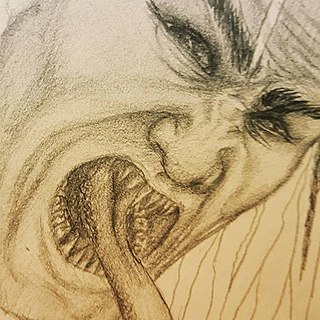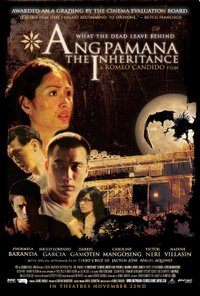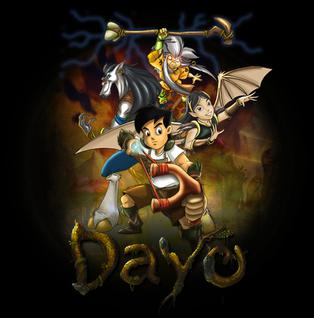
The manananggal is a mythical creature in the Philippines that separates from their lower part of its body and their fangs and wings give it a vampire-like appearance.

Aswang is an umbrella term for various shape-shifting evil creatures in Filipino folklore, such as vampires, ghouls, witches, viscera suckers, and transforming human-beast hybrids. The aswang is the subject of a wide variety of myths, stories, arts, and films, as it is well known throughout the Philippines. Spanish colonists noted that the aswang was the most feared among the mythical creatures of the Philippines, even in the 16th century. Although with no specific motive other than harming others, their behavior can be interpreted as an inversion of the traditional Filipino's values. The aswang is especially popular in southern parts of Luzon, and some parts of Mindanao and Visayas, especially the Visayan province of Capiz.

In Philippine mythology, the kapre is a creature that may be described as a tree giant, being a tall, dark-coloured, hairy, and muscular creature. Kapres are also said to have a very strong body odour and to sit in tree branches to smoke.

The Sigbin or Sigben is a creature in Philippine mythology said to come out at night to suck the blood of victims from their shadows. It is said to walk backwards with its head lowered between its hind legs, and to have the ability to become invisible to other creatures, especially humans. It resembles a hornless goat, but has very large ears which it can clap like a pair of hands and a long, flexible tail that can be used as a whip. The Sigbin is said to emit a nauseating odor.
The penanggal or penanggalan is a nocturnal vampiric entity from Malay ghost myths. Its name comes from the word tanggal meaning to remove or take off, because its form is that of a floating disembodied woman's head with its trailing organs still attached. From afar, it twinkles like a ball of flame, providing an explanation for the will-o'-the-wisp phenomenon.
Pedro Penduko is a Filipino comic book character styled as a folk hero or superhero, created by National Artist for Literature Francisco V. Coching and debuted on the magazine Liwayway.

Ang Pamana: The Inheritance is a 2006 Filipino supernatural thriller film.

Da Adventures of Pedro Penduko is the third and fourth season of the Philippine fantasy TV series Komiks. The third season began airing in the Philippines on September 9, 2006, and ended on April 28, 2007, on the ABS-CBN.
The soucouyant or soucriant in Dominica, St. Lucian, Trinidadian, Guadeloupean folklore in Haiti, Louisiana, Grenada and elsewhere in the Caribbean or Ole-Higue in Guyana, Belize and Jamaica or Asema in Suriname), in The Bahamas and Barbados it is known as Hag. It is a kind of blood-sucking hag.
Mythic humanoids are mythological creatures that are part human, or that resemble humans through appearance or character. Each culture has different mythical creatures that come from many different origins. A major chunk of these creatures are humanoids. They are often able to talk and in many stories they guide the hero on their journey. They are said to come before the creation of gods and goddesses.

Dayo: Sa Mundo ng Elementalia also called Niko: The Journey to Magika in English-speaking countries, is a 2008 Filipino animated adventure-fantasy comedy film and the Philippines' first all-digital full-length animated feature film. Produced by Cutting Edge Productions, the film revolves around Bubuy who has to save his grandparents who were abducted and brought to the strange land called Elementalia, home to a host of strange creatures from Philippine mythology. This $1.3 million production composed of over 500 local animators features a “tra-digital animation” technique using paperless 2D and 3D technologies. It has 2D animation for its characters and 3D animation for the backdrops.
The Wakwak is a vampiric, bird-like creature in Philippine mythology. It is said to snatch humans at night as prey, similar to the Manananggal and the Ekek in rural areas of the Philippines. The difference between the Manananggal and the Wakwak is that Wakwak cannot separate its torso from its body while the Manananggal can. Some believe the Wakwak is a form of vampire. Other people contend that a Wakwak is a Philippine night bird associated with witches.
Dalaketnon, are the evil engkanto. Dalaketnons are a race of Elf-like creatures in Philippine mythology In Visayans they were believed to be handsome and beautiful creatures that resemble nobles and monarchs of the prehispanic Philippines, They dwell on Dalakit trees hence the name Dalakitnon which literally means From the Dalakit or Dakit tree These mythological race exhibits sexual dimorphism the men having light colored skin and very dark hair and women having bronze-brown skin and brown hair. Stories say that they have leaf-shaped pointy ears. depicted in modern times as gothic-like tall, handsome males and beautiful females. They dress in fashionable manner, live in the "haunted house-like" mansions and try to fit in with mortal people. Some believe that the only way to Dalaket, their dwelling place, is by entering the Dalaket trees. These creatures abduct people and take them to their world. They hold a feast for their victims and force them to eat the Black Rice that put them under their spell making them their slaves.
The Mandurugo is a mythical being from Philippine folklore, similar to a vampire.

Shake, Rattle & Roll is a 1984 Filipino horror anthology film directed by Emmanuel H. Borlaza, Ishmael Bernal, and Peque Gallaga. It is the first installment in the Shake, Rattle & Roll film series. This was the only film in the series to be produced and distributed by Athena Productions, with the rest of the installments produced and distributed by Regal Films.

Aso ni San Roque is a Philippine television drama fantasy series broadcast by GMA Network. Directed by Don Michael Perez, it stars Mona Louise Rey. It premiered on September 10, 2012, on the network's Telebabad line up replacing Makapiling Kang Muli. The series concluded on January 11, 2013, with a total of 90 episodes. It was replaced by Indio in its timeslot.

Ang Manananggal sa Unit 23B is a 2016 Philippine romantic gore independent film directed by Prime Cruz under The IdeaFirst Company and starred Ryza Cenon, Martin del Rosario, Cholo Barretto, and Vangie Labalan.
In the Philippines, a handful of superstitious beliefs exist that are very famous amongst the natives. These beliefs are typically introduced to them at a very early age through children's books or bedtime stories. It is believed that if natives aren't careful to follow them, a curse will befall them.








